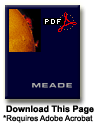| Professional
instrumentation for the demanding school, college, or
university research program—or as the ultimate
personal telescope for the advanced amateur.
With features generally offered only on
custom-manufactured professional instruments, this
largest of all Meade Schmidt-Cassegrains (in fact, the
largest production Schmidt-Cassegrain in the world)
fulfills the most demanding state-of-the-art
requirements for the school, college, or university
teaching or research program, or for the advanced
amateur.
Professional-grade optical system: Continuing
the tradition of Meade 8", 10", and 12"
SCT optics, the 16" LX200GPS yields the superlative
imaging required in advanced applications, whether in
planetary or deep-space visual or CCD imaging,
"...[with
my 16" LX200] in just three weeks I have discovered
two supernovae...The first was found on December 17,
2000, in the galaxy NGC 2526 at a magnitude of 18.8,
with just a 90 second exposure...I took 2,676 CCD images
using a Meade f/6.3 focal reducer to make my first
discovery...The second supernova is designated as 2001h
and was discovered at magnitude 17.5 and rising. I took
1,332 CCD images to make my 2nd discovery. I want to
tell you how pleased I am with the performance of the
16" LX200...I ran a 5.5 hour continuous scripting
routine that secured 268 consecutive galaxies. The
pointing accuracy was outstanding with every galaxy
positioned within 4 arc minutes of the center of the 512
x 512 array. This is a totally out-of-the-box stock
telescope...To search for supernovae requires a
telescope that will take unguided images for at least 90
seconds, and the Meade 16" LX200 has
research-quality optics and drive systems. [My] images
are a testament to the telescope's smooth drive
system....It's a pleasure working with a terrific
instrument capable of performing real astronomical
research."
— Bob Holmes, Jr.
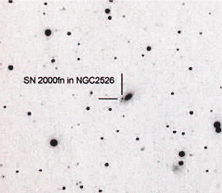
| Discovery
image by Bob Holmes, Jr. of Supernova 2000fn on
December 17, 2000. The supernova, at magnitude
18.8, lies in the 14th-magnitude galaxy NGC 2526
in Cancer. Mr. Holmes obtained this CCD image in
a 90-sec. exposure with the Meade 16" LX200
Schmidt-Cassegrain. The faintest objects in this
image are about 20th-magnitude. |
in astrophotography, or in photometry. And, with its
superclear BK7 optical glass correcting plate, the
16" LX200GPS may be used into the ultraviolet
spectral region as well. Adding the Meade Ultra-High
Transmission Coatings group increases the
telescope's effective image-brightness and resolution
aperture over the visible spectrum to 17.3".
Oversize one-piece fork mounting: The massive
16" LX200GPS fork system, cast in one continuous
piece from one Declination housing to the other,
includes a total of four 80mm roller bearings in
Declination (two in each Declination housing) and two
roller bearings in Right Ascension (one each 100mm and
150mm bearings in the RA housing). Such liberal usage of
precision roller bearings into the telescope's design
permits the addition of substantial auxiliary equipment
without risk of strain on the mechanism and results in
the most rigid tracking platform available on a
production telescope. Large DC-servo-motor-driven
11" worm gears on both telescope axes yield the
smooth, precision tracking and slewing required of a
professional instrument.
Autostar II technology: The purchaser of a
Meade 16" LX200 is acquiring some of the most
advanced technology ever built into a commercial
telescope. Technology that includes all of the following
features:
Automatic GO TO capability to any of 145,000
objects in the onboard database, or to any RA and Dec.
input to the Autostar II keypad, and with a pointing
precision of better than 2 arc minutes in either the
altazimuth or equatorial mode.
A High-Precision Pointing mode capable of
pointing the telescope, automatically, to a precision of
better than one arc-minute, if required.
165 drive speeds on both axes,
pushbutton-actuated from the Autostar II controller:
0.01x to 1.0x sidereal, variable in 0.01x increments;
2x, 8x, 16x, 64x, 128x sidereal; 1°/sec. to6°/sec.,
variable in 0.1° increments.
Microprocessor-controlled sidereal-rate tracking
(or one of 2000 other incrementally-variable solar,
lunar, or planetary-rates) in either the altazimuth or
equatorial modes, with tracking periodic error at an
observatory-standard 5 arc seconds or less using the
factory-programmed Smart Drive in both RA and Dec.
A progressive-tension primary mirror lock that
effectively cancels any residual image shift while
focusing during visual or imaging applications.

| The
16" LX200GPS, shown with optional #1222
Field De-rotater (arrow), #62 T-Adapter, and a
35mm camera body attached to the
standard-equipment Zero-Image Shift Microfocuser.
The #1222 unit connects to a Field De-rotater
port on the telescope's control panel. The
optical tube's Thermal Stabilization Fan,
provided as standard equipment, is visible at
the "12 o'clock" position of the
telescope's rear cell, with the primary mirror
lock-knob located just below-right of the fan. |
The Meade 4-speed Zero Image-Shift Microfocuser
for precise focusing in sensitive lunar, planetary, or
deep-space observing and simultaneously to maintain
precise image centration in CCD imaging applications.
Modern control-panel design, with connectors
for a wide range of optional accessories and features,
including CCD autoguider, illuminated reticle eyepiece,
field de-rotater, and optical tube thermal stabilization
fan, as well as an RS-232 serial port connector.
Supergiant Field Tripod and Permanent Piers:
The 16" LX200GPS is offered with a choice of tripod
or piers, each suitable to specific user applications:
Supergiant Field Tripod: Supplied with the
Supergiant Field Tripod, the 16" LX200GPS is
remarkably field-transportable for an instrument of its
aperture and specifications. The telescope is
manufactured in four basic modules (optical tube
assembly with Declination housings attached; fork arm
system; drive base; and field tripod) and, as such, is
readily transported and set-up in the field by two
adults in about 10 minutes. The extremely strong and
rigid tripod assembly, incorporating 4"-diameter
steel tripod legs, results in virtually no compromise
whatever in telescope stability, as compared to the
permanent pier systems described below.
Placed atop the Supergiant Field Tripod, the 16"
LX200GPS operates in the altazimuth mode with the
tracking and pointing accuracies previously described.
For visual observing, or for CCD imaging or
astrophotography not exceeding four to five minutes'
duration, no additional equipment is required. During
longer periods of imaging or photography, however, field
rotation, an effect inherent to any altazimuth-mounted
telescope, becomes apparent. The result of such field
rotation during photography or imaging is to cause stars
at the outer edge of the field to appear to rotate
relative to the centrally-located star, even if the
exposure is perfectly guided. This effect can be
cancelled completely and precisely by adding the
optional Meade #1222 Field De-rotater (below).
Permanent Altazimuth Pier: For observatory
applications the 16" LX200GPS may be ordered with
the Permanent Altazimuth Pier, a mounting system that
results in comfortable, readily-accessible eyepiece
positions at all telescope pointing locations and is
ideal in those environments where the instrument must be
housed in a minimum of space.
|
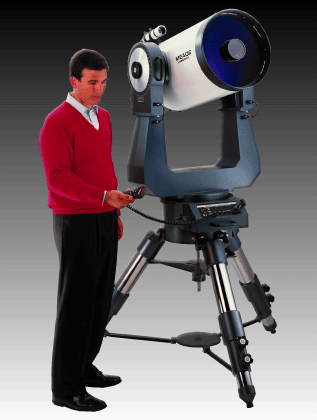
| Meade
16" LX200GPS Schmidt-Cassegrain telescope,
with Supergiant Field Tripod. |
Permanent
Equatorial Pier: If auxiliary astro cameras or other
long-exposure imaging devices are to be piggybacked to
the telescope, then the telescope should be specified
with the Permanent Equatorial Pier. Thus mounted in the
equatorial mode, there is no field rotation in either
the main telescope or in any auxiliary, piggybacked
instruments. All Permanent Equatorial Piers are
custom-manufactured to match the latitude of the
specified observing site.
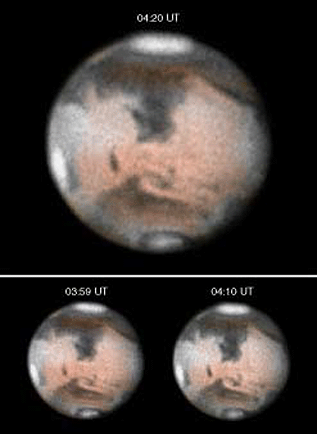
| The
planet Mars, March 29, 1997, imaged by Dr.
Donald Parker using a Meade 16" LX200
telescope and Pictor 416XT imager. In these
images south is up. The north polar cap is
visible below the Utopia region with Syrtis
Major, perhaps the most prominent Martian
surface feature, just south of the equator. The
large white area near Mars' south pole is the
Hellas asteroid impact basin. Dr. Parker writes,
"The Meade 16" LX200 delivers
extraordinary images and is a pleasure to use.
It is rare for a commercial telescope of this
aperture to show stellar images with such
well-defined Airy discs and diffraction rings.
The optical requirements for my imaging work are
extremely high, and the 16" LX200 has fully
met these requirements." |
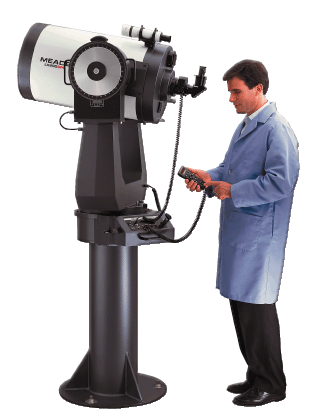
| Meade
16" LX200GPS with Permanent Altazimuth
Pier. As shown, the telescope fits comfortably
inside a 2-meter (7 ft.) dome. |
"...New
Milford [CT] High School is a bustling community of 1500
students and educators — and home to one of the finest
astronomical facilities on any public-school
campus...The observatory's principal telescope is a
Meade 16-inch LX200 Schmidt-Cassegrain permanently
mounted on a rock-solid concrete pier...[The observatory
was] built by volunteers from the Western Connecticut
Chapter of the Society for Amateur Scientists (WCCSAS)...Of
all the achievements to date, [WCCSAS president Monty]
Robson is cheered most by the one that occurred on March
14, 2001, when the International Astronomical Union (IAU)
assigned code number 932 to the observatory. Only
facilities that produce astronomical measurements of the
highest quality are eligible to receive observatory
codes. [The observatory] earned number 932 after WCCSAS
member [Jeff] Miskie submitted precise positions of the
Earth-approaching asteroid 1620 Geographos to the IAU's
Minor Planet Center in late February. 'The images were
taken through the [Meade 16" LX200] with a CCD
camera,' explains Robson, 'and with the school's
parking-lot lights on, a bright Moon in the eastern sky,
and snow covering the ground.' " — from Sky &
Telescope, July, 2001.
Home
Pulse Acquisition: Included as standard equipment
with all 16" LX200GPS models, and unique among
commercial telescopes, is a special "home
pulse" feature that allows the telescope's
operating system to maintain the telescope's pointing
position in non-volatile memory, even when the telescope
is turned off. The advantage of such a system is that
the telescope may be remotely aligned and operated over
an arbitrarily long distance, through a modem link to
the telescope's RS-232 serial interface. In this way
Meade 16" LX200GPS telescopes may be operated
through a pre-programmed sequence of, for example, CCD
imaging, without a human operator being present in the
observatory.
Optional Field De-rotater: For use with the
16" LX200GPS in the altazimuth mode (whether by the
Supergiant Field Tripod or Permanent Altazimuth Pier),
the Meade #1222 Field De-rotater attaches to the rear
cell of the telescope and plugs into a special connector
on the control panel. Digital data fed from the
telescope's microprocessor to the Field De-rotater
permit precise and continuous update of the de-rotation
required to maintain pinpoint star images throughout the
field. The effect is that even during the longest CCD or
photographic exposures, the telescope acts as if it were
precisely equatorially mounted.
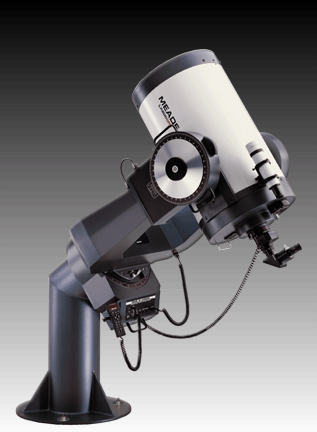
| Meade
16" LX200GPS Schmidt-Cassegrain telescope
on permanent pier for observatory installation. |
Using the Meade 16" LX200GPS: Meade
16" Schmidt-Cassegrain telescopes have been shipped
worldwide to advanced amateurs, schools, and university
observatories, where they are regularly used in programs
of serious astronomical research — research that
ranges from remote imaging and photometry of variable
stars to supernova patrols, asteroid cataloging, and
planetary studies. Shown on this page are images that
attest to the remarkable level of planetary and
deep-space resolution obtainable with the 16"
LX200GPS.
"One
year ago we installed a Meade 16" LX200 Schmidt-Cassegrain
to serve as the primary instrument for our public
observing programs here at McDonald Observatory. The
telescope's professional capabilities such as the GO TO
positioning function and computer interface demonstrate
the excitement of research astronomy to the public. This
has greatly diversified our public programs and allowed
us to observe hundreds of deep-sky objects quickly for
thousands of fascinated users. Housed in its own
permanent observatory and sharing Mt. Locke with
world-class research telescopes, the 16" LX200 is a
fine instrument we are extremely pleased to have
acquired." — Marc Wetzel, University of Texas -
McDonald Observatory, Mt. Locke, TX.
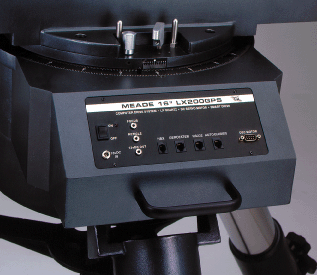
| Control
panel of the 16" LX200GPS. |
Specifications:
16" Model LX200GPS—Includes 16" Schmidt-Cassegrain
optical tube assembly (D = 406mm, F = 4064mm, f/10) with
MgF2 coatings on the correcting lens and standard
aluminum coatings on the primary and secondary mirrors (Ultra-High
Transmission Coatings, available optionally);
primary mirror lock; 4-speed Zero Image-Shift
Microfocuser; heavy-duty, one-piece fork mount with 6
roller bearings and dual-axis 11" worm gears;
7-port multi-function control panel, including RS-232
serial interface and field de-rotater ports; manual and
electric slow-motion controls on both axes; thermal
stabilization fan; setting circles in RA and Dec;
Autostar II control system with 3.5-Megabyte flash
memory, digital readout display, factory-programmed
Smart Drive and 165-speed drive controls on both axes,
High-Precision Pointing, and 145,000-object onboard
celestial software library; GPS alignment system with
16-channel GPS receiver, magnetic declination
compensation, and true-level and North electronic
sensors; home-pulse software for remote telescope
operation; 25 ft. power cord and adapter for telescope
operation from 115v AC (for field operation from 12v DC
auto cigarette lighter plug, see optional #1812A
Electronic DC Adapter); 8x50mm viewfinder; 2"
diagonal mirror with 1.25" adapter; Series 4000
Super Plössl 26mm eyepiece (156x); operating
instructions; shipped in foam-fitted export-quality
cartons. Choice of tripod or piers available at slightly
varying prices: supergiant transportable field tripod;
permanent altazimuth pier; or permanent equatorial pier.
In case of permanent equatorial pier, specify
observatory latitude within 0.5°. |

